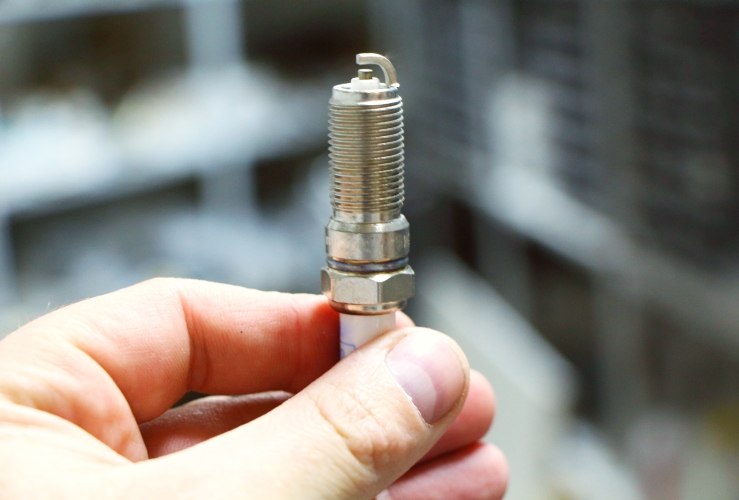If the term ‘spark plug’ fills you with incomprehension, fear not. Our handy guide gives you the low-down on testing, cleaning and replacing this essential motorcycle part.

The spark plug is a fundamental component of your bike’s ignition system. Voltage is sent into the plug from its base, jumping from a centre electrode to a grounded electrode, creating a spark.
This spark ignites the air-fuel mixture in the combustion chamber, causing an explosion that starts the engine power stroke.
Spark plugs differ in size.
- terminal nut
- corrugated ceramic section
- top insulator piece
- hexagonal piece
- metal shell
- gasket
- threaded piece
- nose of the insulator
- centre electrode
- grounded electrode
If the spark plug is the wrong diameter, it may not fit into the combustion chamber; it may be damaged; or it may damage the bike’s internal components.
The reach of the plug determines how far the spark plug reaches into the cylinder. It must be the correct distance. Too short and it won’t be effective; too long and it may cause pre-ignition, get jammed, or may even hit the valve inside.
The plug’s heat range is stamped on the side and is determined by the distance from the tip of the insulator to the ceiling ring. A longer distance designates a hotter plug; a shorter distance a colder one. If the spark plug is too hot, it may cause pre-ignition. A plug that is too cold, on the other hand, can wear out more quickly.
The spark plug gap is the distance between the centre electrode and the grounded electrode. The bigger the gap, the bigger the spark. However, more voltage is required to make the spark when the distance is bigger. A shorter distance will result in a smaller spark and potentially a less complete burn of the air-fuel mixture. Each motorcycle manufacturer will stipulate the spark plug gap distance for their product.
Changing the plug gap size
There are a number of tools available to help measure and adjust the size of a spark plug gap. Refer to your manufacturer for the exact gap size.
Care should be taken when adjusting the gap since the centre and ground electrodes and the insulator can be damaged relatively easily.
How to tell if your spark plug is broken/not functioning
Spark plug testers can be bought online for a few pounds. Remove the high tension lead from the plug. Fix the tester’s boot to the spark plug and the rigid end of the tester to the boot on the bike’s high tension lead, then crank the engine. The tester bulb will flash if the spark plug boot is receiving current.
Alternatively you can insert a screwdriver into the spark plug hole and hold it close to a metal section of the bike, then start the engine. If this creates a spark between the screwdriver and the bike, the plug is working.
However, these tests only demonstrate that current is reaching the spark plug boot. The plug may not be firing inside the combustion chamber – perhaps because it is dirty or wet.
Check your spark plug is working properly
Remove the spark plug from the chamber while keeping the other end connected to the bike. Lay the spark plug against the motor head or other metal part of the bike. Turn the engine over and if you see a spark, it's working. Sparks should be strong and blue, rather than orange or intermittent.
Battery issues
Sometimes a plug won’t work because the battery is not producing enough current. Check your battery is outputting at least 12.6V. Inexpensive altimeters are available online to test this. Such a purchase will prove handy in the long term.
Battery connectors should also be well maintained in order for current to reach your spark plug.
There are a variety of ways to clean a spark plug.
Carburettor cleaner and wire brush
Most motorcycle owners apply carburettor cleaner to their spark plug head, then remove dirt and debris with a wire brush.
Sand blaster
Others purchase a special sand blaster unit to clean the connectors. However, the black media used in such machines can sometimes remain in the spark plug and may well find their way into the engine. Some users also suggest the ceramic insulator glazes over after being sand blasted.
Blow torch
Some mechanics use a blow torch to burn away debris on the electrodes.
Whichever method is used, after cleaning, the spark plug may well need to be re-gapped before being re-installed.
A cleaned plug may work just as well as a brand new one. However, for those with limited mechanical experience, purchasing a new plug may be the preferable option. A new spark plug costs just a few pounds.
Your local motorcycle garage will be able to supply and fit a new spark plug if required. They may do this as part of your maintenance routine.
Take off the spark plug cap. Remove the old spark plug with a wrench of a suitable size. You may wish to plug the hole to prevent debris from entering the engine. Fit the new spark plug by hand tightening it first. Further tighten with a spanner, but be sure not to over-tighten as this may damage the plug.




